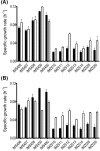Replacement of the initial steps of ethanol metabolism in Saccharomyces cerevisiae by ATP-independent acetylating acetaldehyde dehydrogenase
- PMID: 26818854
- PMCID: PMC5815134
- DOI: 10.1093/femsyr/fow006
Replacement of the initial steps of ethanol metabolism in Saccharomyces cerevisiae by ATP-independent acetylating acetaldehyde dehydrogenase
Abstract
In Saccharomyces cerevisiae ethanol dissimilation is initiated by its oxidation and activation to cytosolic acetyl-CoA. The associated consumption of ATP strongly limits yields of biomass and acetyl-CoA-derived products. Here, we explore the implementation of an ATP-independent pathway for acetyl-CoA synthesis from ethanol that, in theory, enables biomass yield on ethanol that is up to 40% higher. To this end, all native yeast acetaldehyde dehydrogenases (ALDs) were replaced by heterologous acetylating acetaldehyde dehydrogenase (A-ALD). Engineered Ald(-) strains expressing different A-ALDs did not immediately grow on ethanol, but serial transfer in ethanol-grown batch cultures yielded growth rates of up to 70% of the wild-type value. Mutations in ACS1 were identified in all independently evolved strains and deletion of ACS1 enabled slow growth of non-evolved Ald(-) A-ALD strains on ethanol. Acquired mutations in A-ALD genes improved affinity-Vmax/Km for acetaldehyde. One of five evolved strains showed a significant 5% increase of its biomass yield in ethanol-limited chemostat cultures. Increased production of acetaldehyde and other by-products was identified as possible cause for lower than theoretically predicted biomass yields. This study proves that the native yeast pathway for conversion of ethanol to acetyl-CoA can be replaced by an engineered pathway with the potential to improve biomass and product yields.
Keywords: acetyl-CoA; energetics; evolutionary engineering; intracellular metabolites; precursor supply; yeast.
© FEMS 2016.
Figures


Similar articles
-
Replacement of the Saccharomyces cerevisiae acetyl-CoA synthetases by alternative pathways for cytosolic acetyl-CoA synthesis.Metab Eng. 2014 Jan;21:46-59. doi: 10.1016/j.ymben.2013.11.005. Epub 2013 Nov 19. Metab Eng. 2014. PMID: 24269999
-
Introduction of a bacterial acetyl-CoA synthesis pathway improves lactic acid production in Saccharomyces cerevisiae.Metab Eng. 2016 May;35:38-45. doi: 10.1016/j.ymben.2015.09.006. Epub 2015 Sep 15. Metab Eng. 2016. PMID: 26384570
-
Engineering acetyl coenzyme A supply: functional expression of a bacterial pyruvate dehydrogenase complex in the cytosol of Saccharomyces cerevisiae.mBio. 2014 Oct 21;5(5):e01696-14. doi: 10.1128/mBio.01696-14. mBio. 2014. PMID: 25336454 Free PMC article.
-
Engineering cytosolic acetyl-coenzyme A supply in Saccharomyces cerevisiae: Pathway stoichiometry, free-energy conservation and redox-cofactor balancing.Metab Eng. 2016 Jul;36:99-115. doi: 10.1016/j.ymben.2016.03.006. Epub 2016 Mar 23. Metab Eng. 2016. PMID: 27016336 Review.
-
Production of fuels and chemicals from xylose by engineered Saccharomyces cerevisiae: a review and perspective.Microb Cell Fact. 2017 May 11;16(1):82. doi: 10.1186/s12934-017-0694-9. Microb Cell Fact. 2017. PMID: 28494761 Free PMC article. Review.
Cited by
-
Quantitative physiology and biomass composition of Cyberlindnera jadinii in ethanol-grown cultures.Biotechnol Biofuels Bioprod. 2024 Dec 4;17(1):142. doi: 10.1186/s13068-024-02585-3. Biotechnol Biofuels Bioprod. 2024. PMID: 39633424 Free PMC article.
-
Rationally designed perturbation factor drives evolution in Saccharomyces cerevisiae for industrial application.J Ind Microbiol Biotechnol. 2018 Oct;45(10):869-880. doi: 10.1007/s10295-018-2057-x. Epub 2018 Aug 3. J Ind Microbiol Biotechnol. 2018. PMID: 30076552
-
Engineering acetyl-CoA supply and ERG9 repression to enhance mevalonate production in Saccharomyces cerevisiae.J Ind Microbiol Biotechnol. 2021 Dec 23;48(9-10):kuab050. doi: 10.1093/jimb/kuab050. J Ind Microbiol Biotechnol. 2021. PMID: 34351398 Free PMC article.
-
Engineering Plant Secondary Metabolism in Microbial Systems.Plant Physiol. 2019 Mar;179(3):844-861. doi: 10.1104/pp.18.01291. Epub 2019 Jan 14. Plant Physiol. 2019. PMID: 30643013 Free PMC article.
-
Application of cofactors in the regulation of microbial metabolism: A state of the art review.Front Microbiol. 2023 Apr 11;14:1145784. doi: 10.3389/fmicb.2023.1145784. eCollection 2023. Front Microbiol. 2023. PMID: 37113222 Free PMC article. Review.
References
-
- Aristidou A, Penttila M. Metabolic engineering applications to renewable resource utilization. Curr Opin Biotech. 2000;11:187–98. - PubMed
-
- Bahalul M, Kaneti G, Kashi Y. Ether-zymolyase ascospore isolation procedure: an efficient protocol for ascospores isolation in Saccharomyces cerevisiae yeast. Yeast. 2010;27:999–1003. - PubMed
-
- Bekers KM, Heijnen JJ, van Gulik WM. Determination of the in vivo NAD/NADH ratio in S. cerevisiae under anaerobic conditions using alcohol dehydrogenase as sensor reaction. Yeast. 2015;32:541–57. - PubMed
-
- Boeke JD, LaCroute F, Fink GR. A positive selection for mutants lacking orotidine-5′-phosphate decarboxylase activity in yeast: 5–fluoro-orotic acid resistance. Mol Gen Genet. 1984;197:345–6. - PubMed
-
- Bruinenberg PM, van Dijken JP, Scheffers WA. An enzymic analysis of NADPH production and consumption in Candida utilis. J Gen Microbiol. 1983;129:965–71. - PubMed
MeSH terms
Substances
LinkOut - more resources
Full Text Sources
Other Literature Sources
Molecular Biology Databases

